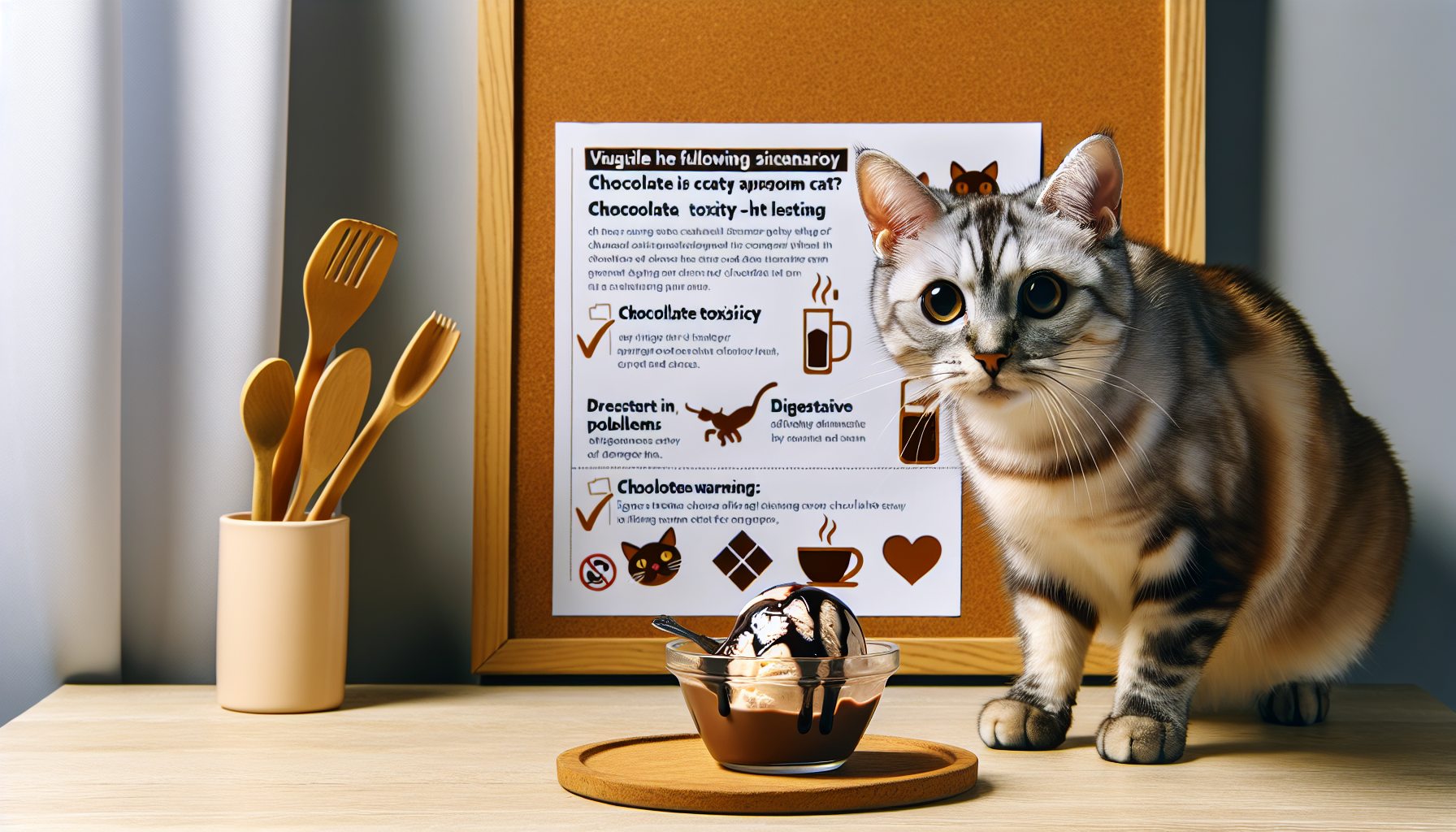Imagine sitting out on a hot summer day, indulging in a delicious bowl of chocolate ice cream. The smooth, creamy texture and rich, decadent flavor making each bite an absolute delight. But have you ever wondered if our feline friends can partake in this sweet treat? The question of whether cats can eat chocolate ice cream often arises, as chocolate is known to be harmful to their health. In this article, we will explore the potential dangers of chocolate for cats and provide you with valuable insights on what foods are safe and unhealthy for your furry companion. So, before you give in to those cute, begging eyes, let’s find out if cats can satisfy their ice cream cravings without compromising their well-being.
Introduction
When it comes to our beloved feline friends, their health and well-being should always be a top priority. As a cat owner, it’s essential to be aware of what foods are safe for your cat to consume and what should be strictly avoided. One popular treat that often raises questions is chocolate ice cream. We all know that cats have a unique palate, but is it safe for them to indulge in this cold and creamy delight? Let’s dive deep into the topic and explore the effects of chocolate ice cream on our feline companions.
Understanding Cats’ Diet
Before we delve into the hazards of chocolate ice cream for cats, it’s crucial to understand the basics of a cat’s natural dietary needs. Cats are obligate carnivores, which means they require a diet primarily composed of animal-based proteins. Unlike humans, cats have specific nutritional requirements that must be met for their optimal health. It’s essential to provide them with a balanced diet that includes high-quality cat food formulated to meet their unique nutritional needs.
Cats’ Natural Dietary Needs
Cats require a diet rich in animal proteins to thrive. Their bodies rely on essential nutrients found in meat, such as taurine, which is crucial for their overall health and well-being. A diet lacking in proper nutrients can lead to a variety of health issues, including heart problems, poor vision, and impaired immune function. Therefore, it is essential to feed your cat a nutritionally complete diet that caters to their specific dietary requirements.
Foods to Avoid for Cats
While cats have a reputation for being finicky eaters, it’s important to note that not all human foods are safe for them. Several common foods can be toxic or harmful to felines, including chocolate, onions, garlic, grapes, raisins, and certain artificial sweeteners like xylitol. These foods can cause a range of health issues, from gastrointestinal upset to kidney failure. It’s always best to err on the side of caution and avoid feeding your cat these potentially dangerous foods.

This image is property of images.unsplash.com.
Hazards of Chocolate for Cats
Chocolate is a popular treat enjoyed by many of us, but it poses significant risks for our furry friends. While cats may be curious creatures and may attempt to sneak a taste of chocolate ice cream or any other chocolate-containing food, it’s crucial to understand the potential toxicity it can pose to their health.
Toxicity of Chocolate for Cats
Chocolate contains a chemical called theobromine, which is highly toxic to cats. Unlike humans, cats lack the necessary enzymes to metabolize theobromine properly. As a result, even small amounts of chocolate can lead to theobromine poisoning in felines. It’s important to keep all chocolate products out of your cat’s reach to prevent any accidental ingestion.
Theobromine Poisoning
Theobromine poisoning occurs when a cat ingests chocolate and the theobromine levels in their body exceed what their system can handle. Symptoms of theobromine poisoning can vary depending on the amount of chocolate consumed, but they can include vomiting, diarrhea, increased heart rate, muscle tremors, seizures, and even death in severe cases. If you suspect your cat has ingested chocolate, immediate veterinary attention is crucial to prevent further complications.
Negative Effects on Cats’ Health
Aside from theobromine poisoning, chocolate and chocolate ice cream can have other detrimental effects on a cat’s overall health. The high sugar and fat content found in chocolate ice cream can lead to weight gain and obesity in cats, which can increase the risk of various health issues, such as diabetes and joint problems. Additionally, the lactose found in dairy-based chocolate ice cream can cause digestive issues in cats, leading to discomfort and potential allergic reactions.
Impact of Dairy in Ice Cream on Cats
Now that we’ve addressed the hazards of chocolate for cats, let’s take a specific look at the impact of dairy in ice cream on our feline friends. While cats are known for their love of milk, it’s important to understand that dairy products like ice cream may not be suitable for them.
Lactose Intolerance in Cats
Many adult cats are lactose intolerant, which means their bodies lack the necessary enzyme, lactase, to break down lactose, the sugar found in milk. Consuming dairy products, including ice cream, can lead to various digestive issues, such as diarrhea, abdominal pain, and bloating. It’s essential to recognize the signs of lactose intolerance in cats and make appropriate dietary adjustments to prevent any discomfort or health issues.
Digestive Issues
When cats consume dairy products like ice cream, their sensitive digestive systems may struggle to digest the lactose present. This can lead to digestive issues such as flatulence, loose stools, and stomach discomfort. It’s important to monitor your cat’s reaction to any dairy products and adjust their diet accordingly to avoid any adverse effects on their digestive health.
Potential Allergic Reactions
Aside from lactose intolerance, cats can also develop allergies to certain components found in ice cream, such as the milk proteins and other additives. Allergic reactions can manifest in various ways, including skin irritations, itching, excessive grooming, and even respiratory issues. If you notice any signs of an allergic reaction after your cat consumes ice cream or any other dairy product, it’s crucial to consult with your veterinarian for proper evaluation and guidance.

This image is property of images.unsplash.com.
Specific Risks of Chocolate Ice Cream
As if the hazards of chocolate and dairy weren’t concerning enough, the combination of the two in chocolate ice cream poses even greater risks for our feline companions. Let’s explore these specific risks in more detail.
Combined Risks of Chocolate and Dairy
The combination of chocolate and dairy in ice cream can compound the risks for cats. The presence of theobromine in chocolate and lactose in dairy creates a potentially toxic and indigestible mixture for our feline friends. The double impact of these substances can increase the likelihood of theobromine poisoning and exacerbate digestive issues in cats.
High Sugar Content
Chocolate ice cream is notorious for its high sugar content, which can be detrimental to a cat’s health. Cats have unique dietary needs that require minimal to no consumption of sugar. High sugar intake can not only lead to obesity but also contribute to the development of diabetes and dental problems in cats. Therefore, it’s crucial to avoid feeding chocolate ice cream, or any sugary treat, to your feline companion.
Negative Impact on Weight and Blood Sugar
As mentioned earlier, the high sugar and fat content in chocolate ice cream can lead to weight gain and obesity in cats. Obesity can have severe consequences for a cat’s health, such as decreased mobility, joint problems, and an increased risk of various diseases. Furthermore, the high sugar content can disrupt a cat’s blood sugar levels, potentially leading to insulin resistance or diabetes. It’s essential to prioritize your cat’s health and abstain from feeding them chocolate ice cream or other sugary desserts.
Symptoms of Chocolate Poisoning in Cats
Recognizing the symptoms of chocolate poisoning in cats is crucial for prompt and appropriate intervention. If you suspect that your cat has ingested chocolate or chocolate ice cream, watch out for these common signs and seek immediate veterinary attention if they occur.
Agitation and Hyperactivity
One of the initial signs of theobromine poisoning in cats is increased agitation and hyperactivity. If your cat suddenly becomes restless, exhibits excessive energy, or appears unusually agitated, it might be a sign of chocolate ingestion.
Rapid Breathing and Increased Heart Rate
Theobromine affects the cardiovascular system, causing a cat’s heart rate to soar. If you notice your cat breathing rapidly or irregularly, or if you can feel an unusually rapid heartbeat when you gently touch their chest, it could be a symptom of chocolate poisoning.
Vomiting and Diarrhea
Gastrointestinal upset is a common reaction to the ingestion of chocolate in cats. If your cat vomits or experiences diarrhea, especially within a few hours of consuming chocolate or chocolate ice cream, it could be an indication of theobromine poisoning.
Muscle Tremors and Seizures
As theobromine reaches toxic levels in a cat’s body, it can lead to muscle tremors and, in severe cases, seizures. If you observe any uncontrolled muscle twitching or tremors, or if your cat experiences a seizure, it is critical to seek immediate veterinary assistance.

This image is property of images.unsplash.com.
Treatment for Chocolate Poisoning
If you suspect your cat has ingested chocolate or chocolate ice cream and is showing symptoms of theobromine poisoning, it’s essential to act swiftly. Time is of the essence, and seeking immediate veterinary attention can greatly increase the chances of a favorable outcome for your furry friend.
Contacting a Veterinarian
The first step in treating chocolate poisoning is to contact your veterinarian. Provide them with all the necessary information, including the type and amount of chocolate your cat consumed, as well as any symptoms your cat is displaying. The veterinarian will guide you on the next steps to take based on your specific situation.
Inducing Vomiting
In some cases, if the ingestion of chocolate occurred within a short time frame, the veterinarian may instruct you to induce vomiting in your cat at home. This is done using hydrogen peroxide or another safe method prescribed by the veterinarian. However, inducing vomiting should only be done under veterinary guidance, as it can be dangerous in some situations.
Administering Activated Charcoal
Activated charcoal is commonly used in the treatment of chocolate poisoning to help absorb and eliminate theobromine from a cat’s system. The veterinarian may recommend administering activated charcoal to your cat to prevent further absorption of the toxic substance.
Providing Supportive Care
During treatment, your veterinarian will provide supportive care tailored to your cat’s needs. This may include intravenous fluids to maintain hydration, medications to control symptoms and seizures, and close monitoring of vital signs and bloodwork. Always follow your veterinarian’s advice and instructions to ensure the best possible outcome for your cat.
Alternatives to Chocolate Ice Cream
While chocolate ice cream may be off the menu for your feline friend, there are several alternative frozen treats and safe human foods that you can offer them as a special treat. Here are some ideas to keep their taste buds satisfied without compromising their health.
Cat-friendly Frozen Treats
Several frozen treats are specially formulated for cats and cater to their unique dietary needs. Look for cat-friendly ice creams or gelatos that are free from chocolate, dairy, and excessive sugars. These treats are formulated to be safe and delicious for your cat, allowing them to enjoy a cool and refreshing snack without any negative health impacts.
Safe Human Foods for Cats
If you’re looking to share a frozen treat with your feline companion, there are certain human foods that are safe for cats to consume in moderation. Consider freezing small pieces of fresh fruit, such as watermelon or cantaloupe, as a refreshing sweet treat. Another option is freezing low-sodium chicken or fish broth into ice cube trays for a savory and hydrating delicacy. Remember to always consult your veterinarian before introducing any new foods into your cat’s diet.
Consulting a Veterinarian for Recommendations
If you’re unsure about which frozen treats are safe for your cat, it’s always a good idea to consult with your veterinarian. They can provide guidance on specific brands and products that are tailored to your cat’s dietary needs and preferences. A veterinarian’s professional advice ensures that your cat’s treats are not only delicious but also beneficial for their overall health.

Preventing Accidental Access to Chocolate Ice Cream
Prevention is key when it comes to maintaining your cat’s health and safety. By taking certain precautions, you can greatly reduce the chances of your cat accidentally ingesting chocolate ice cream.
Storing Chocolate Ice Cream Securely
To prevent any accidental access to chocolate ice cream, store it securely in a place that is out of your cat’s reach. Opt for tightly sealed containers or place it in a high cabinet or the back of your freezer. By keeping chocolate ice cream in an inaccessible location, you can ensure your cat’s safety and eliminate the temptation for them to sneak a taste.
Educating Family and Visitors
Make sure to educate your family members and any visitors about the potential hazards of feeding chocolate ice cream to your cat. Some people may not be aware of the risks associated with chocolate for cats, so it’s important to communicate these concerns and stress the importance of keeping all chocolate-containing products away from your feline companion.
Avoiding Sharing Food
While it can be tempting to share a treat with your cat, it’s crucial to avoid sharing any food that could be harmful to their health. This includes chocolate ice cream and any other food that is toxic or unsuitable for feline consumption. Educate family members and visitors about the importance of refraining from sharing their food with your cat to prevent any accidental ingestion of harmful substances.
Conclusion
While chocolate ice cream may be a delightful and indulgent treat for us humans, it is not safe for our feline friends. Cats have specific dietary needs that do not include chocolate or dairy products like ice cream. Theobromine poisoning, lactose intolerance, and high sugar content can all have negative effects on a cat’s health. It’s essential to prioritize their well-being by providing them with a nutritionally complete diet and safe treats specifically formulated for cats. By educating ourselves about potential hazards and taking proactive measures to prevent accidental access to harmful foods, we can ensure that our cats lead long, healthy, and happy lives.


